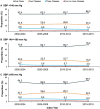Trends in Initial Antihypertensive Medication Prescribing Among >2.8 Million Veterans Newly Diagnosed With Hypertension, 2000 to 2019
- PMID: 39392155
- PMCID: PMC11935568
- DOI: 10.1161/JAHA.124.036557
Trends in Initial Antihypertensive Medication Prescribing Among >2.8 Million Veterans Newly Diagnosed With Hypertension, 2000 to 2019
Abstract
Background: Among patients diagnosed with high blood pressure (BP), initial dual therapy has been recommended for patients with high pretreatment systolic BP (≥160 mm Hg) since 2003, and first-line β-blocker use without a compelling condition has fallen out of favor in US guidelines.
Methods and results: This serial cross-sectional study of national Veterans Health Administration data included adult Veterans with incident hypertension initiating antihypertensive medication between January 1, 2000, and December 31, 2019. We assessed annual trends in initial regimens dispensed (index date: first antihypertensive dispense date) by number of classes and unique class combinations used overall and by pretreatment systolic BP (<140, 140 to <160, and ≥160 mm Hg), as well as trends in subgroups (age, sex, race and ethnicity, and comorbidities warranting β-blocker use). Among 2 832 684 eligible Veterans (average age 61 years, 95% men, 65% non-Hispanic White, and 8% with cardiovascular disease), from 2000-2004 to 2015-2019, initial monotherapy increased across all pretreatment systolic BP levels (<140 mm Hg: 62.1% to 66.4%; 140 to <160 mm Hg: 70.7% to 76.8%; ≥160 mm Hg: 64.2% to 69.7%). Initiation of dual therapy decreased across all pretreatment systolic BP levels (<140 mm Hg: 25.0% to 24.2%; 140 to <160 mm Hg: 20.4% to 17.6%; ≥160 mm Hg: 22.7% to 22.0%). Among 2 521 696 Veterans (89% of overall) without a β-blocker-indicated condition in 2015 to 2019, 20% initiated a β-blocker, most commonly as monotherapy.
Conclusions: More than half of US Veterans diagnosed with hypertension with a pretreatment systolic BP ≥160 mm Hg were started on antihypertensive monotherapy. There are disparities between guideline-recommended first-line treatments and the actual regimens initiated for newly diagnosed Veterans with hypertension.
Keywords: antihypertensive medication; blood pressure; treatment initiation; trends; veteran.
Figures


References
-
- Tschanz MP, Cushman WC, Harrell TE, Berlowitz DR, Sall JL. Synopsis of the 2020 U.S. Department of Veterans Affairs/U.S. Department of Defense clinical practice guideline: the diagnosis and management of hypertension in the primary care setting. Ann Intern Med. 2020;173:904–913. doi: 10.7326/M20-3798 - DOI - PubMed
-
- Whelton PK, Carey RM, Aronow WS, Casey DE Jr, Collins KJ, Dennison Himmelfarb C, DePalma SM, Gidding S, Jamerson KA, Jones DW, et al. 2017 ACC/AHA/AAPA/ABC/ACPM/ AGS/APhA/ASH/ASPC/NMA/PCNA guideline for the prevention, detection, evaluation, and management of high blood pressure in adults: a report of the American College of Cardiology/American Heart Association task force on clinical P. Circulation. 2018;71:e127–e248. - PubMed
-
- James PA, Oparil S, Carter BL, Cushman WC, Dennison‐Himmelfarb C, Handler J, Lackland DT, LeFevre ML, MacKenzie TD, Ogedegbe O, et al. 2014 evidence‐based guideline for the management of high blood pressure in adults: report from the panel members appointed to the eighth joint National Committee (JNC8). JAMA. 2014;311:507–520. doi: 10.1001/jama.2013.284427 - DOI - PubMed
-
- Department of Veterans Administration . VA/DoD Clinical Practice Guideline Management for the Diagnosis and Management of Hypertension in the Primary Care Setting—version 2.0. 2004. [Internet]. 2004 [cited 2024 Jan 4]. https://www.healthquality.va.gov/guidelines/CD/htn/htn04_pdf1.pdf.
-
- Department of Veterans Affairs . VA/DoD Clinical Practice Guideline Management for the Diagnosis and Management of Hypertension in the Primary Care Setting ‐ version 3.0. 2014. [Internet]. 2014 [cited 2024 Jan 4] https://www.healthquality.va.gov/guidelines/CD/htn/VADoDCPGfortheManagem....
MeSH terms
Substances
Grants and funding
LinkOut - more resources
Full Text Sources
Medical

